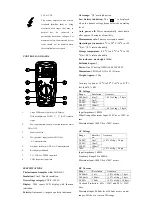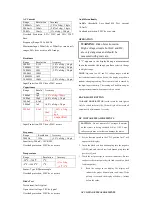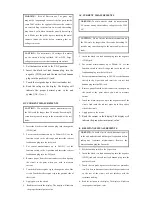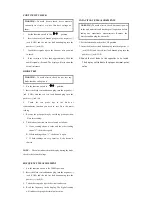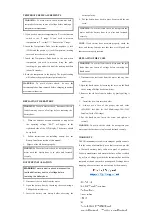
CONTINUITY CHECK
WARNING:
To avoid electric shock, never measure
continuity on circuits or wires that have voltage on
them.
1.
Set the function switch to the position.
2.
Insert the black lead banana plug into the negative (-)
jack (COM) and the red test lead banana plug into the
positive (+) jack (
).
3.
Touch the test probe tips to the circuit or wire you wish
to check.
4.
If the resistance is less than approximately 50
, the
audible signal will sound. The display will also show the
actual resistance.
DIODE TEST
WARNING:
To avoid electric shock, do not test any
diode that has voltage on it.
1. Set the function switch to position.
3. Insert the black test lead banana plug into the negative (-)
jack (COM) and the red test lead banana plug into the
positive (+) jack (
).
4.
Touch the test probe tips to the diode or
semiconductor junction you wish to test. Note the meter
reading
5. Reverse the probe polarity by switching probe position.
Note this reading.
6. The diode or junction can be evaluated as follows:
A. If one reading shows a value and the other reading
shows “1”, the diode is good.
B. If both readings show “1”, the device is open.
C. If both readings are very small or 0, the device is
shorted.
NOTE:
The value indicated in the display during the diode
check is the forward voltage.
FREQUENCY MEASUREMENT
1. Set the function switch to the 20KHz position.
2. Insert the black test lead banana plug into the negative (-)
jack (COM) and the red test lead banana plug into the
positive (+) jack (F).
3. Touch the test probe tips to the circuit under test.
4. Read the frequency in the display. The digital reading
will indicate the proper decimal point, value.
CAPACITANCE MEASUREMENTS
WARNING:
To avoid electric shock, disconnect power
to the unit under test and discharge all capacitors before
taking any capacitance measurements. Remove the
batteries and unplug the line cords.
1.
Set the function switch to the CAP position.
2.
Insert the black test lead banana plug into the negative (-)
jack (COM) and the red test lead banana plug into the
positive (+) jack (CAP).
3.
Touch the test leads to the capacitor to be tested.
The display will indicate the proper decimal point,
value


